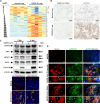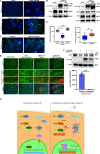Hippo signaling pathway activation during SARS-CoV-2 infection contributes to host antiviral response
- PMID: 36346780
- PMCID: PMC9642871
- DOI: 10.1371/journal.pbio.3001851
Hippo signaling pathway activation during SARS-CoV-2 infection contributes to host antiviral response
Abstract
Severe Acute Respiratory Syndrome Coronavirus 2 (SARS-CoV-2), responsible for the Coronavirus Disease 2019 (COVID-19) pandemic, causes respiratory failure and damage to multiple organ systems. The emergence of viral variants poses a risk of vaccine failures and prolongation of the pandemic. However, our understanding of the molecular basis of SARS-CoV-2 infection and subsequent COVID-19 pathophysiology is limited. In this study, we have uncovered a critical role for the evolutionarily conserved Hippo signaling pathway in COVID-19 pathogenesis. Given the complexity of COVID-19-associated cell injury and immunopathogenesis processes, we investigated Hippo pathway dynamics in SARS-CoV-2 infection by utilizing COVID-19 lung samples and human cell models based on pluripotent stem cell-derived cardiomyocytes (PSC-CMs) and human primary lung air-liquid interface (ALI) cultures. SARS-CoV-2 infection caused activation of the Hippo signaling pathway in COVID-19 lung and in vitro cultures. Both parental and Delta variant of concern (VOC) strains induced Hippo pathway. The chemical inhibition and gene knockdown of upstream kinases MST1/2 and LATS1 resulted in significantly enhanced SARS-CoV-2 replication, indicating antiviral roles. Verteporfin, a pharmacological inhibitor of the Hippo pathway downstream transactivator, YAP, significantly reduced virus replication. These results delineate a direct antiviral role for Hippo signaling in SARS-CoV-2 infection and the potential for this pathway to be pharmacologically targeted to treat COVID-19.
Copyright: © 2022 Garcia et al. This is an open access article distributed under the terms of the Creative Commons Attribution License, which permits unrestricted use, distribution, and reproduction in any medium, provided the original author and source are credited.
Conflict of interest statement
The authors have declared that no competing interests exist.
Figures



Update of
-
Hippo Signaling Pathway Activation during SARS-CoV-2 Infection Contributes to Host Antiviral Response.bioRxiv [Preprint]. 2022 Apr 8:2022.04.07.487520. doi: 10.1101/2022.04.07.487520. bioRxiv. 2022. Update in: PLoS Biol. 2022 Nov 8;20(11):e3001851. doi: 10.1371/journal.pbio.3001851. PMID: 35441167 Free PMC article. Updated. Preprint.
Similar articles
-
Hippo Signaling Pathway Activation during SARS-CoV-2 Infection Contributes to Host Antiviral Response.bioRxiv [Preprint]. 2022 Apr 8:2022.04.07.487520. doi: 10.1101/2022.04.07.487520. bioRxiv. 2022. Update in: PLoS Biol. 2022 Nov 8;20(11):e3001851. doi: 10.1371/journal.pbio.3001851. PMID: 35441167 Free PMC article. Updated. Preprint.
-
Pasteurella multocida activates Rassf1-Hippo-Yap pathway to induce pulmonary epithelial apoptosis.Vet Res. 2024 Mar 16;55(1):31. doi: 10.1186/s13567-024-01285-y. Vet Res. 2024. PMID: 38493147 Free PMC article.
-
Inhibition of coronavirus infection by a synthetic STING agonist in primary human airway system.Antiviral Res. 2021 Mar;187:105015. doi: 10.1016/j.antiviral.2021.105015. Epub 2021 Jan 12. Antiviral Res. 2021. PMID: 33444702 Free PMC article.
-
Involvement of the STING signaling in COVID-19.Front Immunol. 2022 Dec 8;13:1006395. doi: 10.3389/fimmu.2022.1006395. eCollection 2022. Front Immunol. 2022. PMID: 36569928 Free PMC article. Review.
-
Understanding Individual SARS-CoV-2 Proteins for Targeted Drug Development against COVID-19.Mol Cell Biol. 2021 Aug 24;41(9):e0018521. doi: 10.1128/MCB.00185-21. Epub 2021 Aug 24. Mol Cell Biol. 2021. PMID: 34124934 Free PMC article. Review.
Cited by
-
Eye disease drug as a potential cure for COVID-19: one foot-in-the-door.Eye (Lond). 2023 Oct;37(14):2844-2846. doi: 10.1038/s41433-023-02449-4. Epub 2023 Feb 22. Eye (Lond). 2023. PMID: 36813997 Free PMC article. No abstract available.
-
Broad-spectrum antiviral inhibitors targeting pandemic potential RNA viruses.bioRxiv [Preprint]. 2023 Jan 20:2023.01.19.524824. doi: 10.1101/2023.01.19.524824. bioRxiv. 2023. Update in: Cell Rep Med. 2023 May 16;4(5):101024. doi: 10.1016/j.xcrm.2023.101024. PMID: 36711787 Free PMC article. Updated. Preprint.
-
Impaired instructive and protective barrier functions of the endothelial cell glycocalyx pericellular matrix is impacted in COVID-19 disease.J Cell Mol Med. 2024 Aug;28(16):e70033. doi: 10.1111/jcmm.70033. J Cell Mol Med. 2024. PMID: 39180511 Free PMC article. Review.
-
The pathogenetic influence of smoking on SARS-CoV-2 infection: Integrative transcriptome and regulomics analysis of lung epithelial cells.Comput Biol Med. 2023 Jun;159:106885. doi: 10.1016/j.compbiomed.2023.106885. Epub 2023 Mar 31. Comput Biol Med. 2023. PMID: 37084641 Free PMC article.
-
Dysfunctional cardiomyocyte signalling and heart disease.Curr Opin Cell Biol. 2025 Jun;94:102517. doi: 10.1016/j.ceb.2025.102517. Epub 2025 Apr 16. Curr Opin Cell Biol. 2025. PMID: 40245468 Free PMC article. Review.
References
-
- Ramaiah A, Arumugaswami V. Insights into Cross-species Evolution of Novel Human Coronavirus 2019-nCoV and Defining Immune Determinants for Vaccine Development. bioRxiv. 2020:2020.01.29.925867.
Publication types
MeSH terms
Substances
Supplementary concepts
Grants and funding
LinkOut - more resources
Full Text Sources
Medical
Research Materials
Miscellaneous

